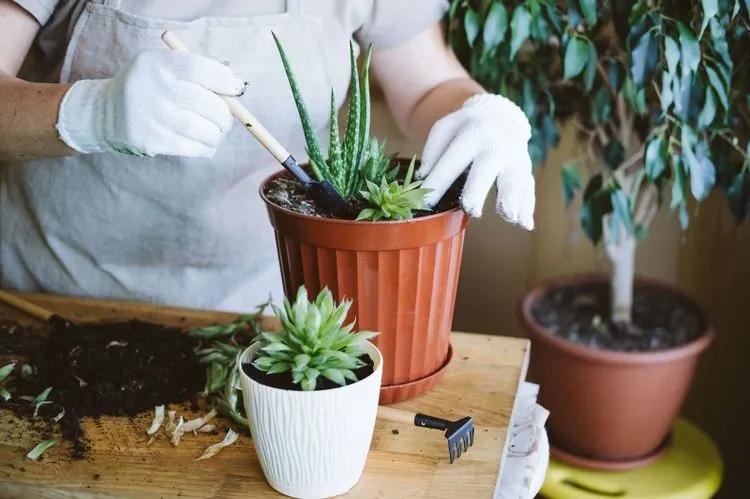
What is the safest way to transplant a houseplant? What kind of pot to choose? How often should you repot the plant? Below we will explain to you the process of repotting step by step.
Signs & Reasons for repotting plants
There are several factors that lead to this decision. If you don’t observe the following reasons, there is no special need for repotting your plant.
- Caked soil. Namely, a very compacted soil that damages the root system of a plant,
- Roots take up a lot of space. If you start to notice that the roots are lifting the plants off the ground, or they are sticking out of the holes in the bottom of the pot, your plant needs a new place,
- Decaying roots. This may happen due to a large amount of water or a mixture of soil, which is not suitable for this type of plant.
- The plant has slowed down its growth or the growth is completely absent.
- You have not transplanted your plant for a long time.
When to repot plants at home?

There are no exact dates for repotting, but try not to disturb your green pets in winter. We recommend you to start repotting in spring, as during this time, it is much easier for plants to adapt to the new environment. In spring, the houseplants may experience less stress than in autumn and winter - these are the dormant seasons for them. Early March is a perfect time for repotting. If you have bought the plant recently, we advise you to wait at least a few weeks before replanting. Also, if the plant prepares for flowering, it is better to postpone the procedure as it can also lead to plant diseases.
What is replanting?
It is a procedure that renews the soil and removes it from the roots. If your houseplant has exhausted its resources and lacks the necessary nutrients, you should replant it to give ‘a second breath’.
How to prepare for repotting?
- Choose a suitable pot size. This is crucial as you’d better take a couple of centimeters more, although, not too much. The volume makes a plant give all its strength to growing new roots. Consider your pot to have drainage holes: thanks to them, nothing will rot inside from moisture.
- Choose a proper soil as there is no all-purpose option for all plants. While one type of soil can support the vital activity of a plant, another may destroy it. Consider the substance and the amount of nutrients in soil, suitable for your plant in advance.
How to repot plants without killing them?

All actions must be performed with special protective gloves. Also, the pot should be thoroughly washed.
- We recommend you get the plant with an earthen lump, holding it in the lower part: this will help you not to damage the roots.
- Shake off the roots. Be careful - the soil should be removed only if mold has formed there or pests have started. In other cases, you can leave it partially, there will be no harm.
- It is not worth rinsing the roots if they look presentable, an excess of water procedures will not be beneficial, but can only aggravate the situation. Cut off the dead areas where rot appeared.
- Move the plant to a new pot (where the expanded clay or small clay ball has formed) as well as some soil. Gradually fill up the earth while holding, periodically tamping it slightly, leaving no empty areas. It is not necessary to squeeze too deep - leave the same level as you did previously.
- Water the plant after repotting.
How to replace the top layer?
Absolutely every houseplant needs an annual renewal of the top layer. The very essence lies in the removal of 2-5 centimeters of soil, depending on the size of the container, where the new one is poured. Houseplants will be grateful to you, and you can rest assured that after the cold season, under the influence of sunlight, they will begin to grow vigorously, receiving all the necessary nutrients.
Pot materials
There are two types of pot material - waterproof and permeable. The clay pot may sooner or later produce wet spots: this indicates that the entire surface is breathing and the water evaporates from the walls. The clay pot is suitable for plants that do not constantly need moist soil. On the other hand, waterproof pots evaporate water only from above: moisture lasts much longer. Often the material that is used for manufacturing is plastic or ceramic.
Drainage
Drainage is a layer of hard and large stones at the bottom of the pot. It allows water to flow easier and helps to adapt the shape to the roots of any plant. The optimal volume is 1/3 of the height of the graft reservoir. Expanded clay is used more often and is easier to find in any specialized stores.
